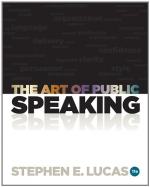Brief description may be by epithet. “Blue-eyed,” “white-armed,” “laughter-loving,” are now conventional compounds, but they were fresh enough when Homer first conjoined them. The centuries have not yet improved upon “Wheels round, brazen, eight-spoked,” or “Shields smooth, beautiful, brazen, well-hammered.” Observe the effective use of epithet in Will Levington Comfort’s “The Fighting Death,” when he speaks of soldiers in a Philippine skirmish as being “leeched against a rock.”
Description uses figures of speech. Any advanced rhetoric will discuss their forms and give examples for guidance.[21] This matter is most important, be assured. A brilliant yet carefully restrained figurative style, a style marked by brief, pungent, witty, and humorous comparisons and characterizations, is a wonderful resource for all kinds of platform work.
Description may be direct. This statement is plain enough without exposition. Use your own judgment as to whether in picturing you had better proceed from a general view to the details, or first give the details and thus build up the general picture, but by all means BE BRIEF.
Note the vivid compactness of these delineations from Washington Irving’s “Knickerbocker:”
He was a short, square, brawny old gentleman, with a double chin, a mastiff mouth, and a broad copper nose, which was supposed in those days to have acquired its fiery hue from the constant neighborhood of his tobacco pipe.
He was exactly five feet six inches in height, and six feet five inches in circumference. His head was a perfect sphere, and of such stupendous dimensions, that Dame Nature, with all her sex’s ingenuity, would have been puzzled to construct a neck capable of supporting it; wherefore she wisely declined the attempt, and settled it firmly on the top of his backbone, just between the shoulders. His body was of an oblong form, particularly capacious at bottom; which was wisely ordered by Providence, seeing that he was a man of sedentary habits, and very averse to the idle labor of walking.
The foregoing is too long for the platform, but it is so good-humored, so full of delightful exaggeration, that it may well serve as a model of humorous character picturing, for here one inevitably sees the inner man in the outer.
Direct description for platform use may be made vivid by the sparing use of the “historical present.” The following dramatic passage, accompanied by the most lively action, has lingered in the mind for thirty years after hearing Dr. T. De Witt Talmage lecture on “Big Blunders.” The crack of the bat sounds clear even today:




